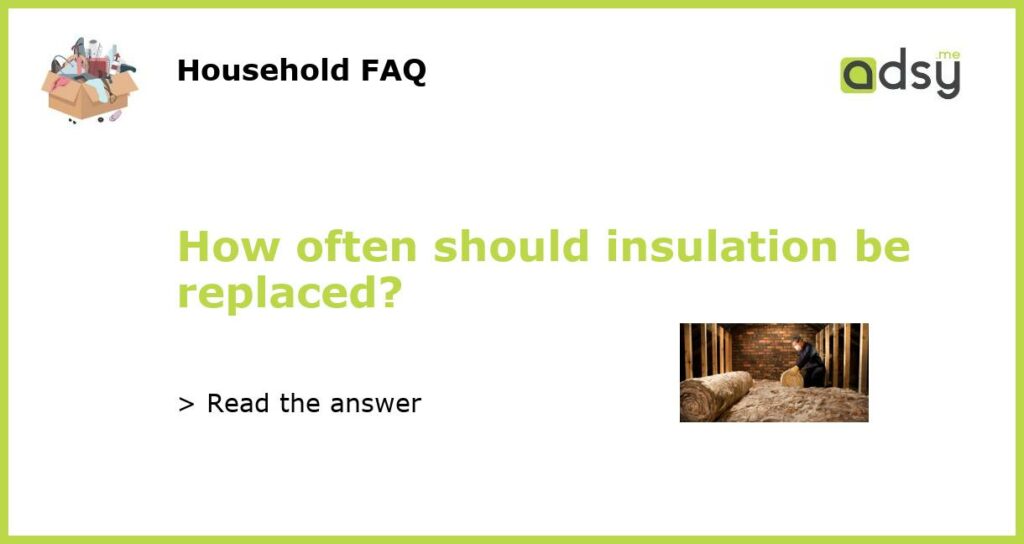How often should insulation be replaced?
Insulation is an essential component of any home or building, providing thermal protection and soundproofing. However, over time, insulation can deteriorate or become less effective, which can impact energy efficiency and indoor comfort. So, how often should insulation be replaced?
The frequency at which insulation needs to be replaced depends on various factors, such as the type of insulation, its condition, and the climate. Generally, insulation can last for several decades, but it’s essential to monitor and assess its condition regularly.
If you have fiberglass batt insulation, it typically has a lifespan of 10-25 years. This type of insulation can deteriorate over time, especially if it gets wet, compressed, or exposed to pests. Therefore, it’s recommended to inspect fiberglass batt insulation every few years and replace it if any issues are detected.
Spray foam insulation, on the other hand, has a longer lifespan of around 30-50 years. This type of insulation provides excellent energy efficiency and can withstand various conditions. However, it’s still essential to check for any signs of deterioration, such as cracking or crumbling, and take appropriate action if necessary.
It’s also vital to consider the climate. Extreme temperature fluctuations, excessive moisture, or high levels of humidity can accelerate the degradation of insulation. In areas with harsher climates, it may be necessary to replace insulation more frequently compared to milder regions.
Signs that your insulation needs replacement
While there isn’t a set timeframe for insulation replacement, there are certain signs that indicate it may be time to replace your insulation:
- High energy bills: If you notice a significant increase in your energy bills despite regular usage patterns, it could be a sign of compromised insulation. Inadequate insulation allows heat to transfer in and out of your home, causing your heating and cooling systems to work harder.
- Drafts and temperature inconsistencies: If you feel drafts or noticeable temperature differences in different areas of your home, it could indicate insulation issues. Inefficient insulation allows outside air to penetrate your home, making it harder to maintain a comfortable indoor temperature.
- Pest infestations: Insulation damage or deterioration can provide entry points for pests like rodents or insects. If you notice signs of pests in your insulation, it’s crucial to address the problem promptly and consider replacing the affected insulation.
- Mold or mildew growth: Moisture can lead to mold or mildew growth in insulation, indicating a potential problem. Moldy or musty odors, visible mold growth, or dampness in the insulation are clear signs that it needs to be replaced.
- Age of the insulation: If your insulation is approaching or surpassing its expected lifespan, it’s a good idea to have it inspected and consider replacement, even if there are no obvious signs of damage.
Benefits of insulation replacement
While insulation replacement may involve some upfront costs, it can provide several significant benefits:
- Improved energy efficiency: Insulation that is in good condition and properly installed helps regulate indoor temperatures, reducing the strain on heating and cooling systems. This can lead to lower energy consumption and cost savings over time.
- Enhanced indoor comfort: Upgrading your insulation can eliminate drafts, temperature inconsistencies, and cold spots, resulting in overall improved comfort in your home.
- Better indoor air quality: Old or damaged insulation can harbor pollutants, allergens, or mold spores, negatively affecting indoor air quality. Replacing insulation can help create a healthier living environment.
- Noise reduction: Insulation plays a vital role in soundproofing, reducing noise transmission between rooms or from outside sources. Upgrading insulation can significantly improve noise control and contribute to a quieter home.
- Increased property value: A well-insulated home is more attractive to potential buyers and can command a higher resale value. Upgrading insulation can be a wise investment that pays off in the long run.
DIY vs. professional insulation replacement
When it comes to insulation replacement, it’s essential to consider whether to tackle the project as a DIY endeavor or hire a professional. While DIY insulation replacement may seem appealing to save money, it’s not always the best option.
Replacing insulation requires specific knowledge, skills, and tools to ensure proper installation. Mistakes during the replacement process can lead to energy inefficiency, moisture problems, or even safety hazards. Therefore, unless you have experience and expertise in insulation installation, it’s generally recommended to hire a professional insulation contractor.
Professional contractors have the expertise to assess your insulation needs, recommend the appropriate insulation type, and ensure correct installation. They can also provide guarantees or warranties on their work, giving you peace of mind and added protection.
Regular maintenance and inspections
While insulation replacement may not be required frequently, regular maintenance and inspections are essential to ensure its optimal performance. Here are some maintenance tips:
- Visual inspections: Regularly inspect your insulation for signs of damage, deterioration, or pest infestations. Address any issues promptly and consider professional inspection if needed.
- Sealing gaps: Check for gaps or cracks around windows, doors, or other potential air leakage points. Properly sealing these gaps can enhance energy efficiency and prevent air infiltration.
- Keep moisture in check: Moisture can compromise insulation effectiveness, so it’s crucial to control humidity levels and address any moisture issues promptly.
- Consider upgrades: If you’re renovating or remodeling your home, it’s an excellent opportunity to upgrade your insulation and improve energy efficiency.
- Professional inspections: It’s recommended to have your insulation professionally inspected every few years to detect any issues early and ensure its optimal performance.
By following these maintenance practices and addressing any insulation issues promptly, you can extend the lifespan of your insulation and enjoy a comfortable, energy-efficient home for years to come.

